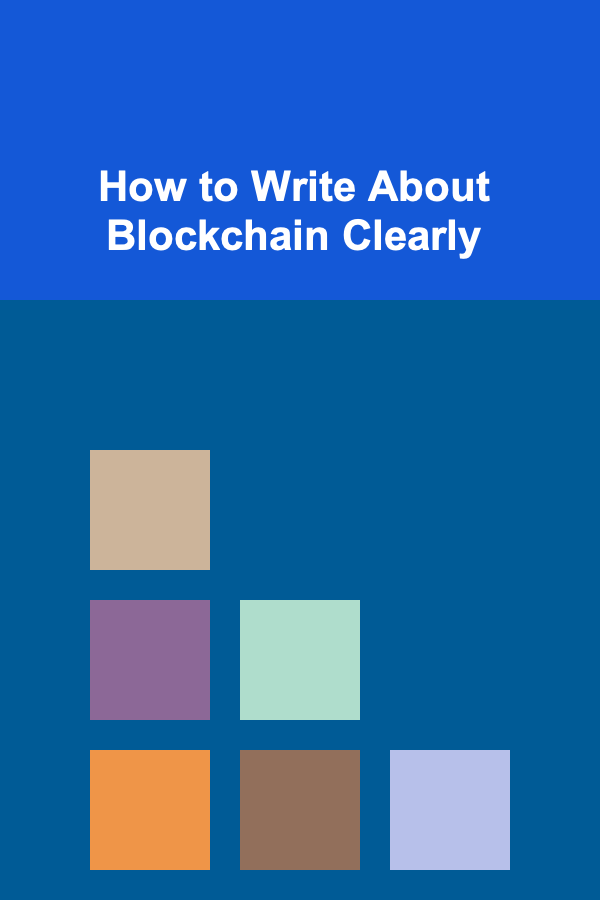
How to Write About Blockchain Clearly
ebook include PDF & Audio bundle (Micro Guide)
$12.99$8.99
Limited Time Offer! Order within the next:

Blockchain technology has revolutionized various industries, from finance and supply chain management to healthcare and voting systems. However, explaining blockchain in a clear and accessible manner can be challenging, especially for audiences unfamiliar with its technical intricacies. This article provides a comprehensive guide on how to write about blockchain effectively, ensuring your message resonates with a diverse readership. We'll explore strategies for simplifying complex concepts, avoiding jargon, providing real-world examples, and maintaining accuracy.
Understanding Your Audience
Before putting pen to paper (or fingers to keyboard), it's crucial to understand your target audience. Are you writing for technical experts, business professionals, or a general audience? Tailoring your language, level of detail, and examples to their existing knowledge base is paramount. Consider these factors:
- Technical Background: Will your audience understand terms like "hash function," "cryptographic key," or "consensus mechanism"? If not, avoid using them or, if necessary, explain them in plain language.
- Industry Knowledge: Are they familiar with the specific industry you're discussing blockchain in (e.g., finance, healthcare)? Contextualize your explanations within their industry-specific knowledge.
- Motivations: Why are they interested in blockchain? Are they looking for investment opportunities, seeking to understand its potential impact on their business, or simply curious about the technology? Address their specific interests and concerns.
Failing to understand your audience can lead to confusion, frustration, and ultimately, a failure to convey your message. Imagine explaining quantum physics to a kindergartener -- it's not the complexity of the topic itself that creates the difficulty, but the mismatch between the information and the audience's ability to process it.
Simplifying Complex Concepts
Blockchain is inherently a complex technology, involving cryptography, distributed systems, and game theory. Effective writing about blockchain requires breaking down these complex concepts into smaller, more digestible pieces. Here are some techniques:
1. Analogies and Metaphors
Analogies and metaphors can be powerful tools for explaining complex concepts in a relatable way. Instead of diving into the technical details of a hash function, you might use the analogy of a digital fingerprint:
"Think of a hash function as a digital fingerprint. It takes any amount of data and produces a unique, fixed-size 'fingerprint' (the hash). Even a tiny change to the original data will result in a completely different fingerprint. This makes it easy to verify the integrity of the data."
Other common analogies include:
- Blockchain as a distributed ledger: Compare it to a shared Google Sheet or a communal accounting book that everyone can view but only authorized parties can modify.
- Cryptographic keys: Explain public and private keys as a mailbox (public key) where anyone can deposit letters (encrypt data), but only the owner with the private key can open the mailbox (decrypt the data).
- Consensus mechanisms: Describe Proof-of-Work (PoW) as a puzzle-solving competition where miners compete to find the solution that allows them to add the next block to the chain.
The key is to choose analogies that are familiar to your audience and accurately represent the underlying technology.
2. Step-by-Step Explanations
Instead of presenting blockchain as a monolithic entity, break it down into its core components and explain how they interact with each other. For example, when explaining a transaction on a blockchain:
- Initiation: Alice wants to send Bob some cryptocurrency. She initiates a transaction on her cryptocurrency wallet.
- Signing: Alice uses her private key to digitally sign the transaction, proving that she authorized it.
- Broadcasting: The transaction is broadcast to the network of nodes (computers) participating in the blockchain.
- Validation: Nodes verify the transaction by checking Alice's signature and ensuring she has sufficient funds.
- Block Creation: Miners or validators group pending transactions into a new block.
- Consensus: The network uses a consensus mechanism (e.g., Proof-of-Work, Proof-of-Stake) to agree on the validity of the new block.
- Chain Extension: The validated block is added to the existing blockchain, making the transaction permanent and immutable.
By breaking down the process into discrete steps, you make it easier for the reader to understand the flow of information and the role of each component.
3. Visual Aids
Visual aids, such as diagrams, flowcharts, and infographics, can significantly enhance understanding. A simple diagram illustrating the structure of a blockchain (blocks linked together with hash pointers) can be far more effective than a lengthy textual description. Consider using tools like:
- Flowcharts: To illustrate the steps involved in a process (e.g., transaction processing, smart contract execution).
- Diagrams: To show the architecture of a blockchain network and the interaction between different nodes.
- Infographics: To present key statistics and facts in a visually appealing and easily digestible format.
4. Focus on the Core Principles
At its heart, blockchain is built on a few core principles: decentralization, transparency, immutability, and security. Instead of getting bogged down in the technical details, focus on explaining these principles and their implications.
- Decentralization: No single entity controls the blockchain. The data is distributed across a network of computers, making it resistant to censorship and single points of failure.
- Transparency: All transactions on the blockchain are publicly visible (though the identities of the participants may be pseudonymous).
- Immutability: Once a transaction is recorded on the blockchain, it cannot be altered or deleted. This ensures the integrity of the data.
- Security: Blockchain uses cryptography to secure transactions and protect against fraud.
By focusing on these core principles, you can provide a high-level understanding of blockchain without overwhelming your audience with technical jargon.
Avoiding Jargon and Acronyms
Blockchain is rife with jargon and acronyms that can be confusing for newcomers. While some technical terms are unavoidable, it's important to use them sparingly and always provide clear explanations when you do. Here are some tips:
1. Define Terms Clearly
When you introduce a new term (e.g., "hash," "Merkle tree," "Byzantine Fault Tolerance"), provide a clear and concise definition. Avoid using jargon to define jargon. For instance, instead of saying "A Merkle tree is a hash tree used for efficiently verifying data integrity," you could say, "A Merkle tree is a way of organizing data in a tree-like structure, where each node is a hash of its child nodes. This allows you to quickly verify that a piece of data is part of a larger set of data without having to download the entire set."
2. Use Plain Language Alternatives
Whenever possible, use plain language alternatives to technical terms. For example:
- Instead of "distributed ledger," use "shared record book."
- Instead of "consensus mechanism," use "agreement process."
- Instead of "cryptographic hash function," use "digital fingerprint."
3. Explain Acronyms
Always spell out acronyms the first time you use them. For example, "Proof-of-Work (PoW) is a consensus mechanism..." Then, you can use the acronym "PoW" throughout the rest of your text. Be mindful of common acronyms within the blockchain space, as some may have different meanings in other contexts (e.g., "DAO" can refer to "Decentralized Autonomous Organization" in blockchain but might mean "Data Access Object" in software development).
4. Create a Glossary
If you're writing a longer piece, consider including a glossary of terms to help readers navigate the technical jargon. This can be especially helpful for complex topics or when targeting a less technically savvy audience.
Providing Real-World Examples
Abstract concepts can be difficult to grasp without concrete examples. Illustrating how blockchain is being used in the real world can help your audience understand its potential and relevance. Here are some examples:
1. Supply Chain Management
Blockchain can be used to track goods as they move through the supply chain, ensuring transparency and preventing counterfeiting. For example, imagine tracking a coffee bean from the farm to the coffee shop. Each step in the process (harvesting, processing, shipping, roasting) can be recorded on the blockchain, providing a verifiable record of the bean's origin and journey.
2. Healthcare
Blockchain can be used to securely store and share medical records, giving patients greater control over their data and improving interoperability between healthcare providers. A patient's medical history, including diagnoses, treatments, and medications, can be stored on the blockchain, accessible only with their permission.
3. Voting Systems
Blockchain can be used to create more secure and transparent voting systems, reducing the risk of fraud and increasing voter participation. Each vote can be recorded as a transaction on the blockchain, making it impossible to alter or delete. The results can be publicly verified, ensuring the integrity of the election.
4. Decentralized Finance (DeFi)
DeFi applications use blockchain technology to provide financial services such as lending, borrowing, and trading without intermediaries. This can provide access to financial services for people who are excluded from traditional banking systems and reduce costs for all users.
When providing examples, be specific and avoid vague generalizations. Describe the problem that blockchain is solving and how it's solving it. Quantify the benefits whenever possible (e.g., "Blockchain reduced transaction costs by 20%").
Maintaining Accuracy and Objectivity
Blockchain is a rapidly evolving technology, and it's important to stay up-to-date on the latest developments. Ensure that your writing is accurate and objective, and avoid making unsubstantiated claims.
1. Research Thoroughly
Before writing about blockchain, conduct thorough research from reputable sources. Consult academic papers, industry reports, and trusted news outlets. Be wary of biased or promotional content.
2. Cite Your Sources
Properly cite your sources to give credit to the original authors and allow readers to verify your information. Use a consistent citation style (e.g., APA, MLA, Chicago).
3. Avoid Hype
While blockchain has the potential to transform many industries, it's important to avoid hyping the technology. Focus on its realistic capabilities and limitations. Acknowledge the challenges and potential risks associated with blockchain adoption.
4. Present Both Sides of the Story
Whenever possible, present both sides of the story. Acknowledge the criticisms of blockchain and address potential concerns. This will demonstrate your objectivity and build trust with your audience.
5. Stay Up-to-Date
The blockchain landscape is constantly changing. New technologies, protocols, and applications are emerging all the time. Make sure to stay up-to-date on the latest developments so that your writing remains accurate and relevant. Follow industry news sources, attend conferences, and engage with the blockchain community.
Structuring Your Content Effectively
The structure of your writing is just as important as the content itself. A well-structured piece is easier to read, understand, and remember. Here are some tips for structuring your blockchain writing:
1. Start with a Clear Introduction
Your introduction should clearly state the purpose of your writing and provide a brief overview of the topics you will cover. Engage the reader by highlighting the importance of blockchain and its potential impact.
2. Use Headings and Subheadings
Headings and subheadings break up the text and make it easier to scan. They also provide a clear outline of the content, helping readers understand the overall structure.
3. Use Bullet Points and Numbered Lists
Bullet points and numbered lists are great for presenting information in a concise and organized manner. They make it easy for readers to quickly grasp key points and steps in a process.
4. Use Short Paragraphs
Long paragraphs can be daunting to read. Break up your text into shorter paragraphs, each focusing on a single idea or concept. This will make your writing more visually appealing and easier to digest.
5. Conclude with a Summary
Your conclusion should summarize the key points you have made and provide a call to action. Encourage readers to learn more about blockchain and explore its potential applications.
Examples of Good and Bad Writing
Let's look at some examples to illustrate the difference between clear and unclear writing about blockchain:
Example 1: The "Hash"
Bad: "A hash is a cryptographic function that maps data of arbitrary size to a fixed-size value. It's a one-way function, meaning it's computationally infeasible to reverse the process."
Good: "Think of a hash as a digital fingerprint. It takes any piece of data and creates a unique, fixed-length 'fingerprint.' Even a tiny change to the original data will result in a completely different fingerprint. This makes it easy to verify the integrity of the data - if the fingerprint matches, you know the data hasn't been tampered with."
Example 2: Smart Contracts
Bad: "Smart contracts are self-executing contracts with the terms of the agreement directly written into code. They facilitate, verify, and enforce the negotiation or performance of a contract. They are immutable and reside on the blockchain."
Good: "Smart contracts are like digital vending machines. You put in the right input (money), and the machine automatically dispenses the output (a product). Similarly, a smart contract automatically executes when certain conditions are met. The terms of the agreement are written directly into the code, and once deployed on the blockchain, they can't be changed."
Example 3: Proof-of-Work (PoW)
Bad: "PoW is a consensus algorithm where miners compete to solve a computationally intensive puzzle in order to add a new block to the blockchain. The miner who solves the puzzle first receives a reward."
Good: "Proof-of-Work is like a puzzle-solving competition. Miners (powerful computers) compete to find the solution to a complex mathematical puzzle. The first miner to find the solution gets to add the next block of transactions to the blockchain and is rewarded with newly minted cryptocurrency. This process requires a lot of computing power, making it expensive to attack the network."
Notice how the "good" examples use analogies, avoid jargon, and provide context to make the concepts more understandable.
Conclusion
Writing about blockchain clearly and effectively requires a combination of technical knowledge, communication skills, and a deep understanding of your audience. By simplifying complex concepts, avoiding jargon, providing real-world examples, and maintaining accuracy, you can make blockchain accessible to a wider audience and help them understand its transformative potential. Remember to always put yourself in the shoes of your readers and tailor your writing to their level of understanding. The future of blockchain depends on our ability to communicate its value and potential to the world.

How to Budget for Sustainable Living Without Sacrificing Comfort
Read More
How to Clean and Maintain Your Refrigerator's Efficiency
Read More
How to Create a Retirement Planning Checklist for Tax-Effective Savings
Read More
How to Create the Ultimate Movie Night Party at Home
Read More
How to Use Mirrors to Create a Sense of Space in Staging
Read More
Printable Signs for Restaurants: Menus, Specials & More
Read MoreOther Products

How to Budget for Sustainable Living Without Sacrificing Comfort
Read More
How to Clean and Maintain Your Refrigerator's Efficiency
Read More
How to Create a Retirement Planning Checklist for Tax-Effective Savings
Read More
How to Create the Ultimate Movie Night Party at Home
Read More
How to Use Mirrors to Create a Sense of Space in Staging
Read More